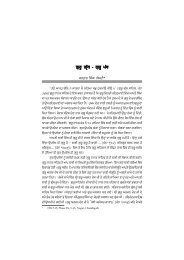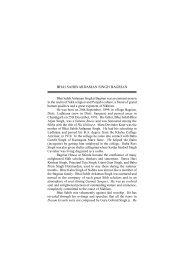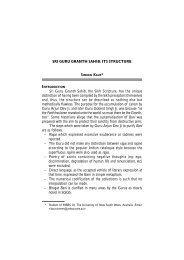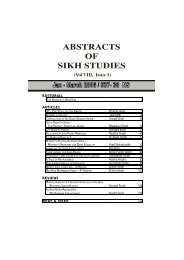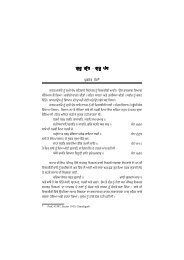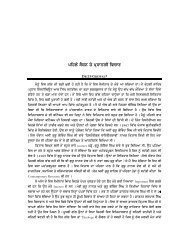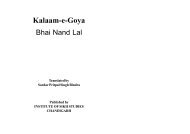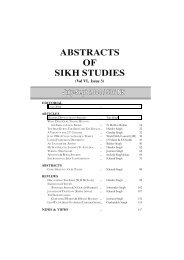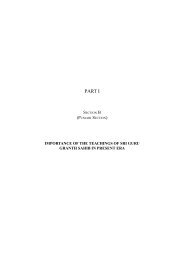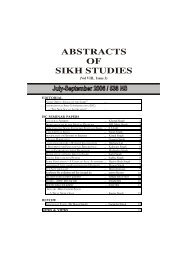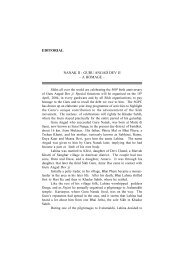editorial articles reviews news & views - Institute of Sikh Studies
editorial articles reviews news & views - Institute of Sikh Studies
editorial articles reviews news & views - Institute of Sikh Studies
Create successful ePaper yourself
Turn your PDF publications into a flip-book with our unique Google optimized e-Paper software.
MCLEOD & FENECH AS SCHOLARS ON SIKHISM AND MARTYRDOM<br />
91<br />
provided manpower as Akali volunteers, and not simply the Jat<br />
community, as Fenech again, improperly would make out. Readers<br />
must take into consideration that for the Gurdwara Reform Movement<br />
all classes <strong>of</strong> <strong>Sikh</strong>s, urban or rural, played their role and any reference<br />
to any section <strong>of</strong> them by Fenech or McLeod, or any <strong>of</strong> his other<br />
collaborators is born out <strong>of</strong> malice. Another thing to be noted is that<br />
non-violence in the Gurdwara Reform Movement was basically because<br />
<strong>of</strong> the <strong>Sikh</strong> ethos and not because <strong>of</strong> Gandhi whose movement for<br />
swaraj within one year cut such a sorry figure. Again, though Congress<br />
did help the <strong>Sikh</strong>s, the same cannot be said <strong>of</strong> Gandhi despite Fenech<br />
mentioning <strong>of</strong> the same.<br />
The constitution <strong>of</strong> Shiromani Gurdwara Parbandhak Committee<br />
(SGPC) on 15 November 1920, was a momentous affair. The<br />
Sharomani Akali Dal with Sarmukh Singh as Jathedar to coordinate<br />
the activities <strong>of</strong> scattered Jathas in January 1921 followed suit. The<br />
Central <strong>Sikh</strong> League was soon eclipsed. The SGPC consisted <strong>of</strong> men<br />
who possessed critical knowledge <strong>of</strong> <strong>Sikh</strong>ism and <strong>Sikh</strong> history, men<br />
who were imbued with nam, and followed a path “sharper than a sword<br />
and straighter than a hair”. Khalsa form was rigidly enforced. The<br />
Gurdwara Reform Movement has been narrated reasonably well with<br />
few exceptions <strong>of</strong> unnecessarily playing on jats among the <strong>Sikh</strong>s or<br />
over-emphasis on militancy which were uncalled for.<br />
Though Fenech uses the word ‘reformers’ for the people running<br />
the 1920 movement, he obviously means revivalists-suffering, standing<br />
true to and dying. He concludes the last chapter saying. “The Tat Khalsa<br />
message truly penetrated Into the very heart <strong>of</strong> the Punjab due in<br />
large part to the martyrdom” -instead it would be much better to say,<br />
the <strong>Sikh</strong> and <strong>Sikh</strong>ism’s idiom.<br />
IX<br />
The author’s concluding summar,’ obviously relates to martyrdom,<br />
because thesis is on martyrdom. It, however, in the words <strong>of</strong> Fenech,<br />
underwent a considerable reduction <strong>of</strong> meaning in view <strong>of</strong> “Singh<br />
Sabha’s emphasis on the Adi Granth as the litmus test <strong>of</strong> all<br />
contemporary <strong>Sikh</strong> tradition.” Further that, it was Tat Khalsa’s victory



